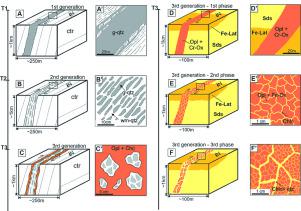Tectonophysics ( IF 2.9 ) Pub Date : 2021-07-22 , DOI: 10.1016/j.tecto.2021.229002 Francisco H. Bezerra 1, 2 , Fabrizio Balsamo 3 , Giulia Corsi 3 , Jean Michel Legrand 1 , Maria O.L. Sousa 1 , Francisco C.C. Nogueira 4 , Emma Salvioli-Mariani 3 , Cristiane P. Menezes 1, 2

|
This study investigates the Samambaia seismogenic fault at the border of the Potiguar rift Basin, Brazil, to evaluate the relationships among hydrothermal processes, seismicity, and preexisting tectonic fabric. The fault is a 27 km-long structure composed of three left-bend, en echelon segments spaced 1.0–1.5 km apart. The segments strike N31°E – N35°E, dip 70° NW and have focal depths between 1 and 9 km. The seismogenic fault coincides with a swarm of silica-rich veins that range in size from a few centimeters wide and 1–2 m long to 20–50 m wide and hundreds of m long. These structures encompass a V1 vein set composed of quartz veins parallel to the Proterozoic-Archean basement metamorphic foliation and a V2 vein set composed of chalcedony, opal, cryptocrystalline silica, and quartz geodes that cut across Cretaceous siliciclastic and carbonate sedimentary units in the basin and the basement. Fluid inclusions from the V1 vein set yield trapping temperatures of 91 °C–336 °C, whereas the V2 vein set yields temperatures of 147 °C–388 °C. The fluid inclusions and oxygen isotope analyses indicate a magmatic fluid source, although contamination by lateritic soil–derived fluids can be recognized in the V2 vein set. We conclude that in the Samambaia fault, fluid pressure reduces the effective stress until the fault experiences failure, contributing to fault weakening and seismicity. Subsequent cooling of hydrothermal fluids leads to fault healing after coseismic slip and precipitation of Si-rich cements. This process was associated with variation from hydrostatic to lithostatic pressure during cementation, reducing permeability along the fault. Then, the fault locks and fluid pressures begin to rise again. We interpret the superposed V1 and V2 vein sets as the expression of fault-valve behavior caused by repeated fluid-driven reactivation through time along preexisting structures in an extended, rifted crust.
中文翻译:

巴西 Samambaia 板内发震断层中的热液硅化作用:对裂谷地壳中断层失去凝聚力和愈合的影响
本研究调查了巴西 Potiguar 裂谷盆地边界的 Samambaia 发震断层,以评估热液过程、地震活动和先前存在的构造结构之间的关系。断层是一个 27 公里长的结构,由三个左弯、梯形段组成,间距为 1.0-1.5 公里。这些段走向 N31°E – N35°E,下倾 70° NW,震源深度在 1 到 9 公里之间。发震断层与一群富含二氧化硅的脉相吻合,这些脉的大小从几厘米宽和 1-2 m 长到 20-50 m 宽和数百米长不等。这些结构包括由平行于元古代-太古代基底变质叶理的石英脉组成的 V1 脉组和由玉髓、蛋白石、隐晶硅、和石英大地,它们穿过盆地和基底中的白垩纪硅质碎屑和碳酸盐沉积单元。V1 脉组的流体包裹体产生的捕集温度为 91 °C–336 °C,而 V2 脉组的俘获温度为 147 °C–388 °C。流体包裹体和氧同位素分析表明是岩浆流体源,尽管在 V2 脉组中可以识别出红土土壤衍生流体的污染。我们得出结论,在 Samambaia 断层中,流体压力会降低有效应力,直到断层发生故障,从而导致断层减弱和地震活动。随后的热液冷却导致在同震滑移和富硅胶结物沉淀后断层愈合。这个过程与胶结过程中从静水压力到岩石静压力的变化有关,降低沿断层的渗透率。然后,故障锁定和流体压力再次开始上升。我们将叠加的 V1 和 V2 脉组解释为断层阀行为的表达,这些断层阀行为是由流体驱动的重复激活导致的,沿着扩展的裂谷地壳中的预先存在的结构随着时间的推移而引起。


























 京公网安备 11010802027423号
京公网安备 11010802027423号